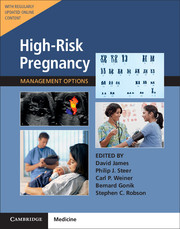Book contents
- Frontmatter
- Contents
- List of Contributors
- Preface
- Section 1 Prepregnancy Problems
- Section 2 Early Prenatal Problems
- Section 3 Late Prenatal – Fetal Problems
- Section 4 Problems Associated with Infection
- Section 5 Late Pregnancy – Maternal Problems
- Section 6 Late Prenatal – Obstetric Problems
- 52 Abdominal Pain in Pregnancy
- 53 Nonmalignant Gynecology in Pregnancy
- 54 Bleeding in Late Pregnancy
- 55 Multiple Pregnancy
- 56 Threatened and Actual Preterm Labor
- 57 Prelabor Rupture of the Membranes
- 58 Breech Presentation, Unstable Lie, Malpresentation, and Malpositions
- 59 Prolonged Pregnancy
- 60 Induction of Labor and Termination of the Previable Pregnancy
- 61 Dysfunctional Labor
- 62 Shoulder Dystocia
- 63 Fetal Compromise in Labor
- 64 Neuraxial Analgesia and Anesthesia in Obstetrics
- 65 Perineal Repair and Pelvic Floor Injury
- 66 Assisted Vaginal Delivery
- 67 Delivery After Previous Cesarean Section
- 68 Cesarean Section
- Section 7 Postnatal Problems
- Section 8 Normal Values
- Index
61 - Dysfunctional Labor
from Section 6 - Late Prenatal – Obstetric Problems
- Frontmatter
- Contents
- List of Contributors
- Preface
- Section 1 Prepregnancy Problems
- Section 2 Early Prenatal Problems
- Section 3 Late Prenatal – Fetal Problems
- Section 4 Problems Associated with Infection
- Section 5 Late Pregnancy – Maternal Problems
- Section 6 Late Prenatal – Obstetric Problems
- 52 Abdominal Pain in Pregnancy
- 53 Nonmalignant Gynecology in Pregnancy
- 54 Bleeding in Late Pregnancy
- 55 Multiple Pregnancy
- 56 Threatened and Actual Preterm Labor
- 57 Prelabor Rupture of the Membranes
- 58 Breech Presentation, Unstable Lie, Malpresentation, and Malpositions
- 59 Prolonged Pregnancy
- 60 Induction of Labor and Termination of the Previable Pregnancy
- 61 Dysfunctional Labor
- 62 Shoulder Dystocia
- 63 Fetal Compromise in Labor
- 64 Neuraxial Analgesia and Anesthesia in Obstetrics
- 65 Perineal Repair and Pelvic Floor Injury
- 66 Assisted Vaginal Delivery
- 67 Delivery After Previous Cesarean Section
- 68 Cesarean Section
- Section 7 Postnatal Problems
- Section 8 Normal Values
- Index
Summary
Introduction
The primary goal for all involved in the care of women in labor is a healthy mother and baby after delivery. For most pregnancies, which are low risk, delivery by cesarean section appears to pose greater risk of maternal morbidity and mortality than vaginal delivery and can have significant implications for future pregnancies.
Unfortunately, we do not have a reliable method to predict accurately those women who will have a successful uncomplicated vaginal delivery. This reflects the multifactorial nature of labor, with its multitude of variables that can complicate even the most seemingly low-risk situation. It is our duty, as clinicians, to offer women up-to-date evidence-based management options that will deliver the best possible outcome for women and their babies.
The incidence of labor dystocia is difficult to determine, as there is little consensus on the length and progress of normal labor. Despite this, “failure to progress” remains one of the most common indications for emergency cesarean section according to a recent critical narrative review of research on “dystocia in labour” published in the English language from 1998 up to July 2013. Equally, the reported maternal and fetal morbidity associated with poor progress varies considerably, reflecting the discrepancies in diagnostic criterion and wide variations amongst populations. In extreme cases, labor dystocia may reflect obstructed labor resulting in vesicovaginal fistula, uterine rupture, and fetal or maternal death. Other morbidities such as chorioaminitis, sepsis, postpartum hemorrhage (PPH), and poor fetal outcome have been described. Furthermore, owing to the lack of high-quality evidence, standard guidelines do not apply in every case.
This chapter describes how labor starts, how it should be diagnosed and monitored, the recognition of slow versus normal progress, the causes of slow progress (maternal and fetal), and the interventions available to correct slow progress, together with an assessment of their effectiveness. In each section, an explanation of the underlying (patho-)physiology will enable the clinician to adopt an individual approach to labor dystocia.
- Type
- Chapter
- Information
- High-Risk Pregnancy: Management OptionsFive-Year Institutional Subscription with Online Updates, pp. 1750 - 1775Publisher: Cambridge University PressFirst published in: 2017

